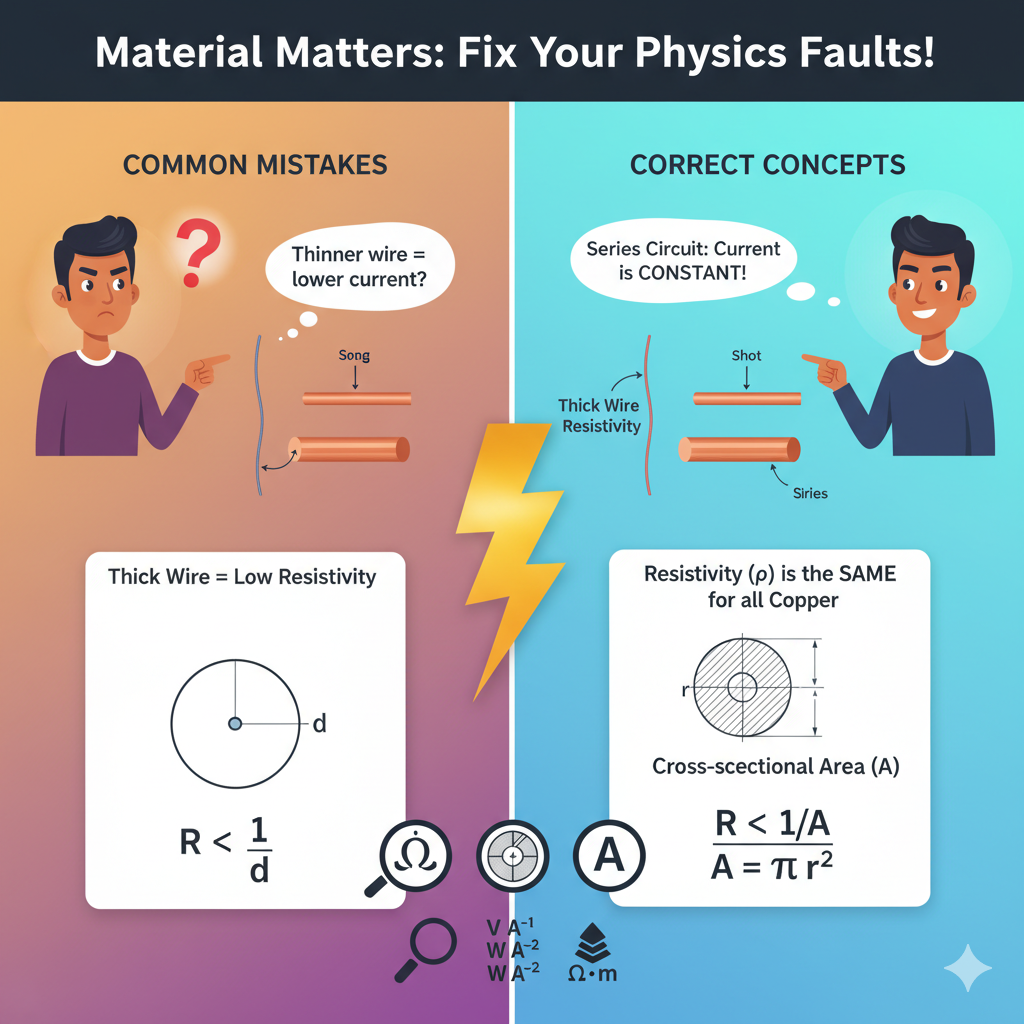You know the one I’m talking about. The question about two copper wires—one thick, one thin—and you have to figure out the resistance. You use the formula, you double-check your math, but your answer is still wrong.
Sound familiar?
It’s one of the most common frustrations in electricity, but I promise, it’s not as hard as it looks. You’re likely falling for one of three sneaky traps that catch almost everyone. Let’s expose them, fix them, and make sure you nail these questions every single time.
Trap #1: The Identity Crisis — Mixing Up Resistance and Resistivity
Okay, let’s be honest. “Resistance” and “Resistivity” sound almost the same. It’s easy to think they are. This is the #1 reason students get confused.

Here’s the only analogy you’ll ever need:
Resistivity is like a material’s DNA. Resistance is how that material behaves in the real world.
Every piece of copper in the universe has the same resistivity (ρ). It’s a fundamental property, like its color or density. You can’t change it unless you change the material itself. You an view a video that clearly explains how resistivity remains same for wires of different lengths and thickness here
But a wire’s resistance (R) depends on its shape. A long, skinny copper wire will put up a huge fight against current (high resistance), while a short, fat copper wire will let it flow easily (low resistance).
So, when a question says “two wires are made of the same material,” your brain should immediately think: “Aha! Same resistivity.”
- Wrong thought: “Longer wire = higher resistivity.”
- Right thought: “Longer wire = higher resistance. The resistivity is the same.”
Simple change, but it makes all the difference.
Trap #2: The Sneakiest Trick in the Book — The Diameter Trap
This one feels like it was designed to trick you. The question says, “The diameter of a wire is doubled,” and your gut reaction is, “Great! Resistance is cut in half.”

WRONG.
Remember, the electricity doesn’t care about the diameter. It cares about the total space it has to move through, which is the cross-sectional area.
Let’s look at the formula: R=ρAL
It’s all about the Area (A). And what’s the formula for the area of a circle? A=πr2.
See that little ‘squared’ symbol? That’s the trap.
Let’s walk through it:
- If you double the diameter, you also double the radius (r→2r).
- But when you calculate the new area, you have to square that new radius: Anew=π(2r)2=4πr2.
- The area just got FOUR TIMES BIGGER!
So, if you double a wire’s thickness, you make the path for the current four times larger. This means the resistance drops to one-quarter of its original value.
If you want to see this in action, check out our video where we solve this exact type of problem step-by-step!
Trap #3: The “Wait, What?” Unit Confusion
We all know resistance is measured in Ohms (Ω). But on a multiple-choice test, you might see options like VA−1 or WA−2 and have a mini-panic.
Don’t sweat it. A unit for a physical quantity can come from any valid equation it’s in.
- From Ohm’s Law (R=V/I), the unit is Volts per Ampere (V/A or VA−1). Easy enough.
- But what about the power formula, P=I2R? If we rearrange that, we get R=P/I2. The units here would be Watts per Ampere-squared (W/A2 or WA−2).
It’s a perfectly correct, just less common, unit for resistance. Seeing this shows you understand the concepts, not just one formula.
Your New Cheat Sheet for Wire Problems
Tired of falling for these traps? Here are your new rules:
- Same Material? Same Resistivity. Don’t mix them up.
- Diameter Doubled? Resistance is Quartered. Always think in terms of area (A=πr2).
- Weird Units? Check the Formulas. Don’t panic; just see which formula could produce those units.
That’s it. These three ideas are the key. Master them, and that annoying wire problem will become one of the easiest questions on your test. You’ve got this. For clarifying more such misconceptions to solve resistance and resistivity problems without committing any mistakes, view all the problems from this playlist.











